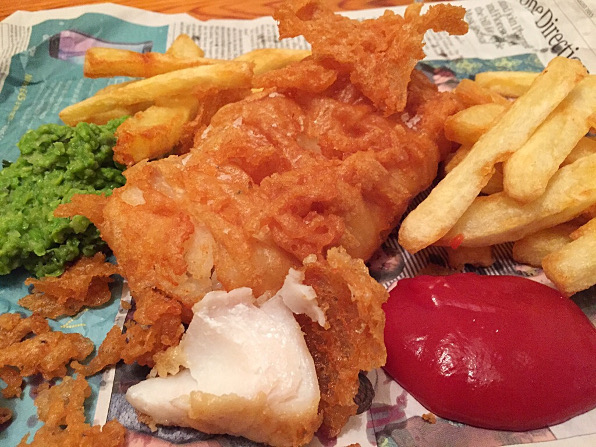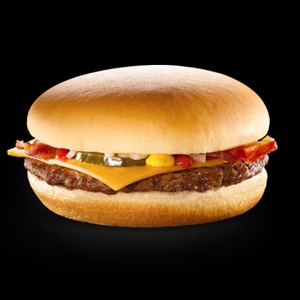The original appeal of iconic street foods – the result of qualities that endeared them to folks from very different cultures than those that created them – remained preserved in those forms and flavours as they spread cross the world with the advance of ‘civilization’…
 Beautiful Fish and Chips: Right off the the newsprint,
Beautiful Fish and Chips: Right off the the newsprint,
from a traditional London Street vendor…
The problem is, some of the original dishes have, in many cases, been so ‘developed’ and ‘evolved’ by subsequent generations that they bear little resemblance to their ancestors. Some have been rendered so bulky and complicated that can’t even be grabbed and ‘taken away’ anymore like they were originally intended to be. Yet, others have remained ‘accessible’ as street foods. And I think I know why…
Shared characteristics
On closer inspection (and consideration), we note that most of the venerable (some downright ancient) street foods we know today all share a few vital characteristics:
- They’re one-handable.
- They can be wrapped in paper (or whatever) and stuffed in a pocket, purse or saddle bag.
- They have only a few essential ingredients. No complicated or expensive inventories for the vendor to manage.
- The ingredients they do include are all ‘naturals’ together.
- They are quick and simple to assemble for the vendor and quick and easy for the consumer to access.
- They require no tableware or eating utensils.
- They leave behind very little or no garbage, and most of what they do produce can be recycled, composted or otherwise kept out of the landfill.
Alas! Many foods that started out this way have become encumbered by decorations, toppings, sauces and other stuff that’s traditionally alien to real Street Food, and lost some of their principle claims to the name.
The way they used to be…
Today, Pizza (for example) is generally heavily topped with gooey ingredients and served on soft, floppy crusts.
I was reminded of what Pizza is supposed to be last night when I screened my pre-recorded copy of Stanley Tucci’s ‘Searching for Italy’ episode on Naples and the Amalfi Coast. They still consider Pizza a hand-held Street Food there, in the town where the modern Pizza was invented. The most famous Pizza in the world, the Margarita, is just a thinnish crust, a little Marinara Sauce, Grated Parm or Romano Cheese, Fresh Mozzarella and Fresh Basil Leaves.
The master Pizzaiolo who made one for Tucci threw it together in a blur of hands and a few well-chosen words, and just tossed it in his (literally) blazing-hot wood-burning oven.
“Forty-five seconds is all it should take,” he remarked meaningfully. It came out beautifully crisp (with a slightly chewy centre), bubbling toppings and nowhere over-or under-browned, on the bottom or edges.
A flash of revelation…
That, I thought, is the best looking New York Style Pizza I’ve ever seen. Contrast that with the heavy, gooey, drippy thick-crust creations they call ‘traditional’ in other major American cities and around the world. There’s really no comparison. Whether you eat it flat or folded – either is legit according to the Neapolitan natives I saw eating it with Tucci – the crust must be stiff enough to support the relatively light cargo of toppings.
Then, still a bit in awe, I realized: It wasn’t Naples that copied New York, was New York’s Neapolitan immigrants who brought their Pizza to the Big Apple and taught Americans how to make it!
An essential commonality
The same goes for any street food that is based on some common family ingredient or 2-3 ingredient dish wrapped in the flatbread of its native cuisine is really just a cousin of the Neapolitan Pizza. The wonder is, most of the dozens of variants around the world were developed by their various originators independently of each o0ther.
Take the common Taco. It’s just a few essential ingredients on a warm, flexible Corn Tortilla. Among the most traditional: Carnitas, Beans and Rice and Pulled meats. All the other stuff that has been added over the generations to make Tacos less of a snack and more of a meal. the Middle East, they have several traditional specialties that follow more or less the same model.
How about the Greek and north Mediterranean dishes we call ‘wraps’? Same deal, just wrapped a little differently.
Stuff on Buns
All the things we eat on Buns, Bread or similar products are al descended from one almost accidental moment of inspiration back a few hundred years or so ago, when one man who stopped at his favourite ‘diner’ lunch but was running late told the proprietor, “Just put the meat between two slices of Bread. I gotta make up some time, here…”
And the Bread component of any of these menu items is what ultimately qualifies them as Street Food, fulfilling the key one-handed, no-utelsils requirements of our list.
Consider, if you will, the simple constituents of the basic Hamburger or Hot Dog: Meat on a bun. Maybe some simple condiments and a slice of Cheese. And that’s how our forebears first came to love them. The rest of the toppings ‘regional styles’ and other differentiators we have available today were all added by culinary sideshow barkers attempting to make their products stand out from the crowd. Don’t even get me started on the crazy names they give their over-dressed patties and sausages. They leave me cold, for the most part. I want to taste taste the meat!
Note to fellow Foodies: What we call Buns or Rolls these days were originally referred to as ‘Loaves’, back when everybody got their own at mealtimes, and subsisted on Bread and Beer, in Renaissance times. Beer? You couldn’t drink the filthy water. Bread? All bread was Wholegrain then, with none of the components removed, bleached or otherwise processed out of it. Whoever coined the phrase, “Bread is the staff of life” wasn’t kidding!
Take any Street Food…
In Ireland, they have that wonder of the field hand’s lunch-packet, the Hand Pie. Usually based on Pork, bound together with lots of fat, eaten warm or cold, its sturdy short-pastry exterior makes it stout enough to take-with even without a paper wrapper.
English Fish and Chips are traditionally eaten right off of a folded sheet of used newspaper, with the fingers, often while walking or siting on a park bench. Just Deep-fried Fish and what we now commonly refer to as fried Potato Wedges. Enhancements? Malt Vinegar, Salt and maybe a squeeze of Lemon. Traditionalists would balk at anything fancier or more complicated.
Asian Dim Sum (Dumplings) may be served with simple dipping sauces. But usually, as Street Food, it’s not.
Korean Bahn Mi Sandwiches? Usually just the Roasted/Grilled/ BBQed meat on soft, cloud-like Flatbread.
Getting the idea?
Now… Ask yourself:
How many of the above foods can you just grab-and-go with, in their contemporary forms, these days? Not many. They’ve been ‘enhanced’ to the point that almost need a new descriptive.
But on the whole… The more Street Foods change, the more their basic, iconic forms remain the same. And no matter how you serve them, folks love them just the same.
Take a moment to appreciate the Street foods you encounter in your travels – whether it be on the way to work or trekking the Andean Jungle paths. If you just take them for granted, you’re cheating yourself of some enchanting opportunities!
~ Maggie J.

